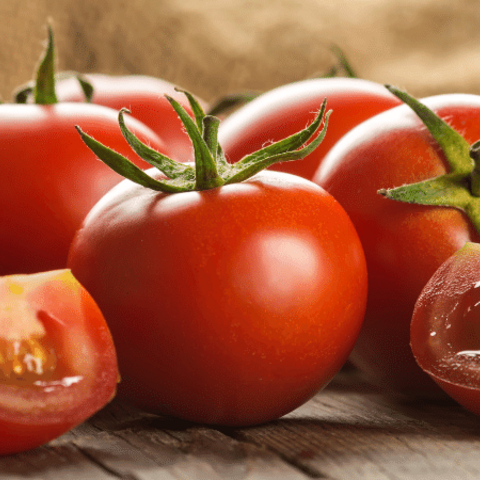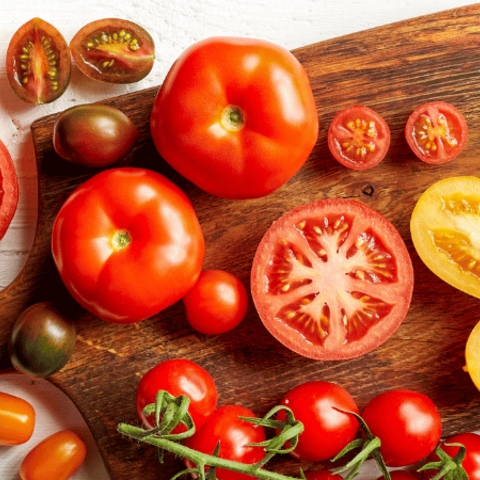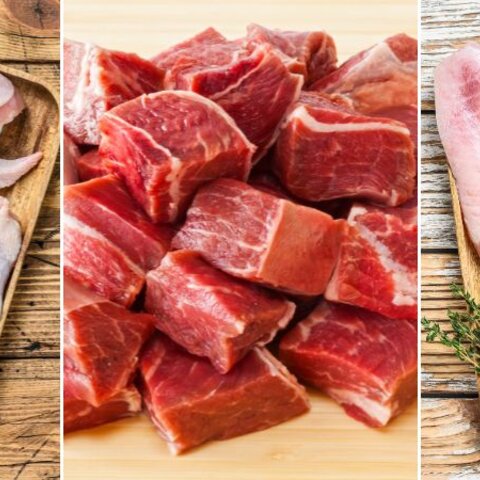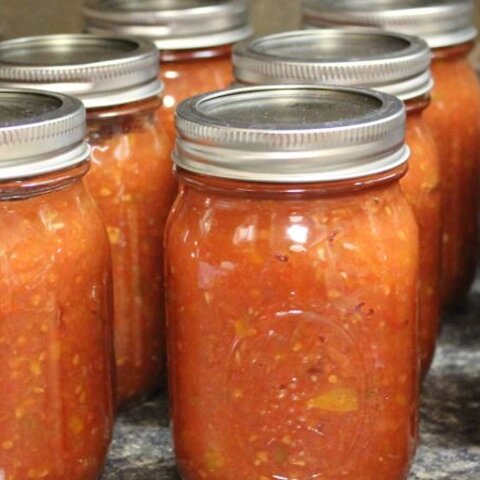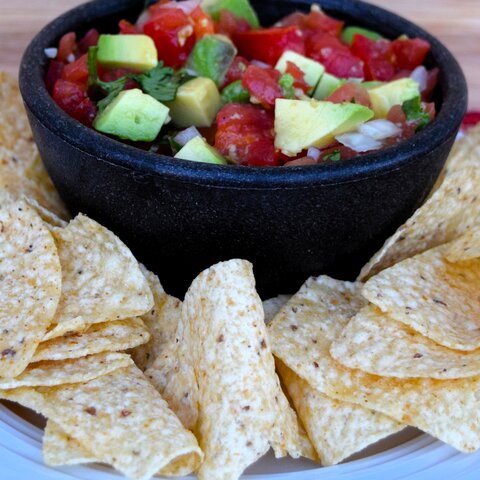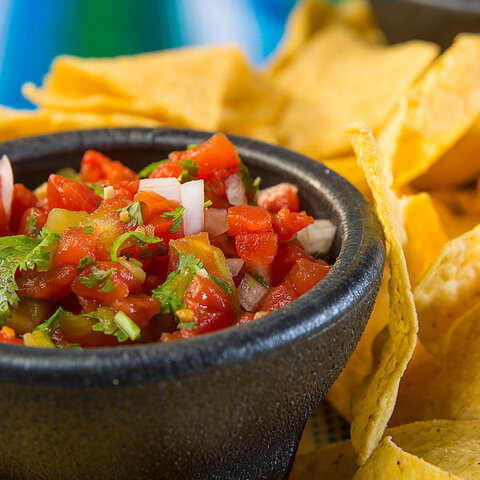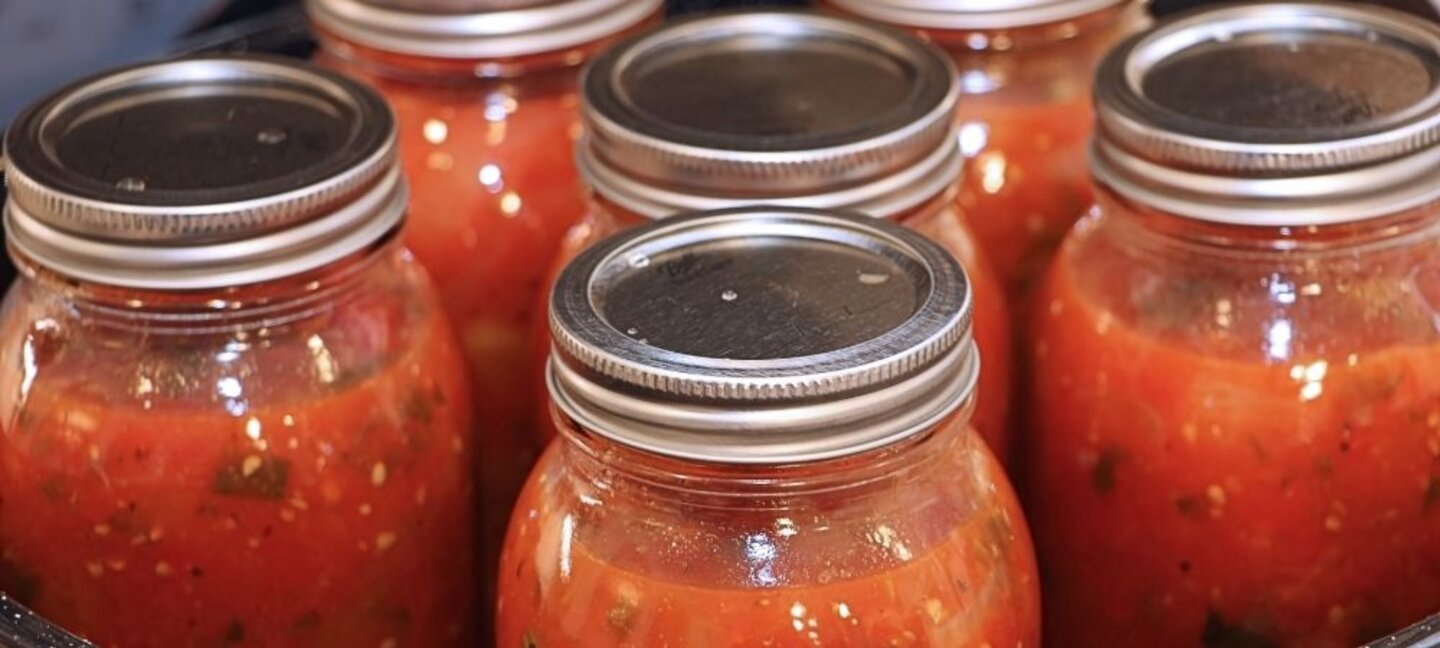
Home canning tomatoes is a excellent way to enjoy your harvest long after the growing season is done. Processing times and instructions have been scientifically determined to ensure safe products free of molds, yeasts, and bacteria. It is extremely important to follow the tested recipes for canning tomatoes and tomato products.
Tomato Selection and Preparation | Steps for Canning Tomatoes | Recipes for Canning
Tomato Selection and Preparation
- Select disease-free, preferably vine-ripened, firm tomatoes for canning. Do not home can over-ripe tomatoes or those from dead or frost-killed vines. These will result in a poor quality and a potentially unsafe canned product. Green tomatoes are more acidic than ripened fruit and can be canned safely with any recommendation in this publication.
- For nine pints of canned tomato products, 13-14 pounds of tomatoes are required. Approximately 23 pounds are needed for seven quarts of canned product.
- To prepare fruit, wash, remove stems, and trim bruised or discolored portions. To remove the peel, dip tomatoes in boiling water for 30 to 60 seconds until skins split. Dip into cold water, slip off skins and remove the cores.
- Tomatoes can be canned with or without salt. Salt seasons the product but is not necessary for a safely canned food. If salt is desired, add ½ teaspoon to pints or 1 teaspoon to quarts before placing the lid on the jar. Add salt substitutes, if desired, when serving.
- A commercially produced seasoning packet intended for home canning can be used but the directions and ingredients should not be changed as this may result in a potentially unsafe canned product.
Steps for Canning Tomatoes Safely
New to canning or need a refresher? Canning Basics provides information on the basics of canning such as the different methods of canning, jar and lid selection, preparation, filling and processing steps.
Methods of Processing for Tomatoes
- Tomatoes can be safely processed in a boiling-water canner, steam canner or pressure canner.
- The atmospheric steam canner is fairly new to home canning. It uses only 2 quarts of water (compared to 16 quarts, or more, in a boiling-water canner). Because less water is heated, processing can start more quickly. Process time is based on the recommended time for a boiling-water canner. Processing time in a steam canner is limited to 45 minutes or less, including any modification for elevation.
- Tomatoes and tomato products processed using a pressure canner will often result in higher quality canned tomato products.
- Tomato-vegetable mixtures such as spaghetti sauce must be processed in a pressure canner. It is not safe to increase the portions of vegetables such as onions, celery, peppers or mushrooms from tested recipes.
Adding an Acid
- A high acid level (pH of 4.6 or less) prevents the growth of Clostridium botulinum bacteria which causes botulism.
- Tomatoes usually are considered an acidic food, although some varieties may have pH values above 4.6. Additional acid such as lemon juice must be added to boiling-water canning, steam canning and pressure canner options to ensure a safe product.
- Treat heirloom tomato varieties the same as any other tomato. The acidity of heirloom tomatoes is no different from the non-heirloom varieties. The same acidification recommendations apply for canning heirloom tomatoes.
- To ensure proper acidity in tomatoes, add one of the following acids directly to each jar before filling with product:
Table 1: Acidifying Tomatoes
| Acid | Pints | Quarts |
|---|---|---|
| Bottled lemon juice | 1 tablespoon | 2 tablespoons |
| Citric acid | ¼ teaspoon | ½ teaspoon |
| Vinegar (5% acidity) | 2 tablespoons | 4 tablespoons |
- When using lemon juice, use only commercially bottled juice. There is an industry standard for bottled lemon and lime juice, which ensures accurate and consistent acidification. The acidity of freshly squeezed lemons and limes is very unpredictable. As they become riper, they have less acidity.
- Add sugar to offset acid taste, if desired.
- Vinegar may cause an undesirable flavor.
- Adding acid to over-ripe tomatoes will not increase the acid level enough to ensure a safe product.
Determining Elevation
Water boils at 212°F at sea level. As the elevation increases, water boils at lower temperatures and foods take longer to cook. This map shows Nebraska elevations. You need to know your elevation to determine the correct processing time when canning. For those living outside of Nebraska, you can find your elevation at your local planning commission or zoning office, on a webpage or use an app.
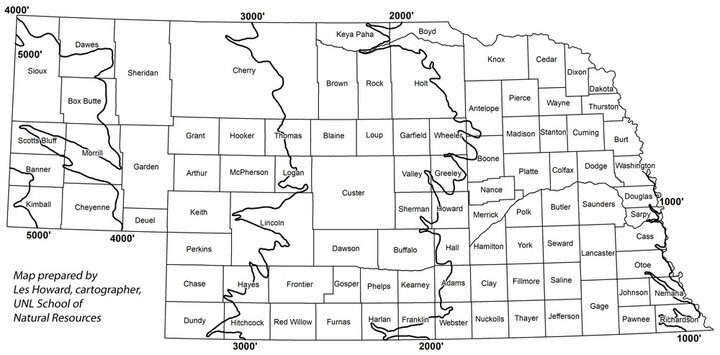
Figure 1. Elevation ranges in Nebraska. Map was prepared by Les Howard, cartographer, UNL School of Natural Resources
Recipes for Canning Tomatoes
- Salsas
- Tomato Ketchup
- Pickled Tomatoes
- Tomato Juices
- Crushed Tomatoes
- Tomato Sauce
- Whole or Halved Tomatoes
- Spaghetti Sauces
- Mexican Tomato Sauce
Salsas
Chili Salsa (Hot Tomato-Pepper Sauce)
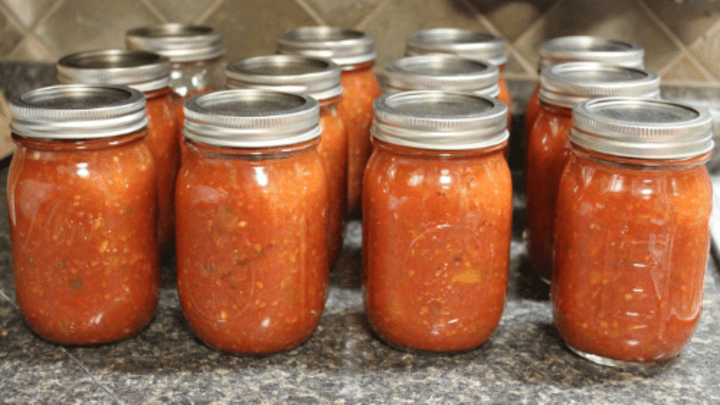
- 5 pounds tomatoes
- 2 pounds chile peppers
- 1 pound onions, chopped
- 1 cup vinegar (5% acidity)
- 3 teaspoons salt
- ½ teaspoon pepper
Yield: about 6 to 8 pints
- Caution: Wear plastic or rubber gloves and do not touch your face while handling or cutting hot peppers. If you do not wear gloves, wash hands thoroughly with soap and water before touching your face or eyes.
- Carefully measure all ingredients to ensure safe processing in a boiling-water canner or steam canner.
- Wash hands with soap and water. Make sure counters and equipment are clean. Wash and dry chiles. Slit each pepper on its side to allow steam to escape. Peel peppers by placing chiles in oven (400°F) or broiler for six to eight minutes until skins blister. Allow peppers to cool. Place in a pan and cover with a damp cloth. After several minutes, peel each pepper. Discard seeds and chop peppers.
- Wash tomatoes and dip in boiling water for 30 to 60 seconds or until skins split. Dip in cold water, slip off skins and remove cores. Coarsely chop tomatoes and combine chopped peppers, onions, and remaining ingredients in a large saucepan. Heat to boil and simmer 10 minutes. Fill product into prepared hot jars, leaving ½-inch headspace. Remove air bubbles and readjust headspace to ½-inch.
- Wipe rims of jars with a dampened clean paper towel. Adjust lids and bands. Process in a boiling-water canner or steam canner according to the recommendations in Table 2. Wait 5 minutes before removing jars from canner.
Table 2: Processing Times for Chili Salsa in Boiling-water Canner or Steam Canner
| Process at Altitudes of: | ||||
|---|---|---|---|---|
| Style of Pack | Jar Size | 0-1,000 ft | 1,001-6,000 ft | Above 6,000 ft |
| Hot | Pints | 15 minutes | 20 minutes | 25 minutes |
Basic Salsa
- 6 cups peeled, cored, seeded, and chopped ripe tomatoes
- 9 cups diced onions and/or peppers of any variety (see below for substitutions)
- 1 ½ cups bottled lemon or lime juice
- 1 tablespoon canning or pickling salt
Yield: about 6 pints
Substitutions: Do not increase the amount of peppers or onions the in recipe. Yellow, white, or red onions can be substituted for each other but DO NOT increase the total amount of onions.
- Wash hands with soap and water. Make sure counters and equipment are clean. Wash and rinse pint or half-pint canning jars; keep hot until ready to fill. Prepare lids and ring bands according to manufacturer’s directions.
- Dip washed tomatoes in boiling water for 30 to 60 seconds or until the skins split. Submerge immediately in cold water. Peel off loosened skins and remove cores. Remove seeds and chop (¼- to ½-inch pieces). Peel, wash, core, and dice onions (¼-inch pieces). Wash and core bell peppers. Remove the seeds and membranes before dicing (¼-inch pieces). Wash and remove stems of hot peppers. Keep or remove as much of the seeds and membranes as you wish, depending on the ‘pepper heat’ of the salsa that you desire. Dice peppers (¼-inch pieces).
- Combine prepared ingredients in a large pot; add lemon juice and salt. Bring to a boil over medium heat while stirring. Reduce heat and simmer salsa for an additional 3 minutes, stirring as needed to prevent scorching. Fill the hot salsa into prepared hot jars, leaving 1/2-inch headspace. Remove air bubbles and re-adjust headspace to ½-inch. Wipe rims of jars with a dampened clean paper towel. Adjust lids and bands. Process in a boiling-water canner or steam canner according to the recommendations in Table 3. Wait 5 minutes before removing jars from canner.
Table 3: Processing Times for Basic Salsa in Boiling-water Canner or Steam Canner
| Process Time and Altitudes of | ||||
|---|---|---|---|---|
| Style of Pack | Jar Size | 0-1,000 ft | 1,001-6,000 ft | Above 6,000 ft |
| Hot | Half-pint or Pint | 15 minutes | 20 minutes | 25 minutes |
Mango Salsa
- 6 cups diced unripe mango (about 3 to 4 large, hard green mangoes)
- 1 ½ cups diced red bell pepper
- ½ cup finely chopped yellow onion
- ½ teaspoon crushed red pepper flakes
- 2 teaspoons finely chopped garlic
- 2 teaspoons finely chopped ginger
- 1 cup light brown sugar
- 1 ¼ cups cider vinegar (5% acidity)
- ½ cup water
Yield: 6 half-pint jars
Caution: Handling green mangoes may irritate the skin of some people in the same way as poison ivy. They belong to the same plant family. To avoid this reaction, wear plastic or rubber gloves while working with raw green mango. Do not touch your face, lips or eyes after touching or cutting raw green mangoes until all traces are washed away.
- Wash hands with soap and water. Make sure counters and equipment are clean. Wash and rinse half-pint canning jars; keep hot until ready to use. Prepare lids according to manufacturer's directions. Wash all produce well. Peel and chop mango into ½-inch cubes. Dice bell pepper into ½-inch pieces. Finely chop yellow onions. Combine all ingredients in an 8-quart Dutch oven or stockpot. Bring to a boil over high heat, stirring to dissolve sugar. Reduce to simmering, and simmer 5 minutes.
- Fill hot solids into clean, hot half-pint jars, leaving ½-inch headspace. Cover with hot liquid, leaving ½-inch headspace. Remove air bubbles and adjust headspace if needed. Wipe rims of jars with a dampened, clean paper towel. Adjust lids and bands. Process in a boiling-water canner or steam canner according to the recommendations in Table 4. Wait 5 minutes before removing jars from canner.
Table 4: Processing Times for Mango Salsa in Boiling-water Canner or Steam Canner
| Process times at altitudes of: | ||||
|---|---|---|---|---|
| Style of Pack | Jar Size | 0-1,000 feet | 1,001-6,000 feet | Over 6,000 feet |
| Hot | Half-pint | 10 minutes | 15 minutes | 20 minutes |
Return to top | Return to recipes
Tomato Ketchup
- 24 pounds ripe tomatoes
- 3 sticks cinnamon, crushed
- 3 cups chopped onions
- 1 ½ teaspoons whole allspice
- 3/4 teaspoon ground red pepper (cayenne)
- 3 tablespoons celery seeds
- 1 ½ cups sugar
- 3 cups cider vinegar (5% acidity)
- ¼ cup salt
- 4 teaspoons whole cloves
Yield: about 6 to 7 pints
- Wash hand with soap and water. Wash tomatoes and dip in boiling water for 30 to 60 seconds or until skins split. Dip in cold water, slip off skins and remove cores. Quarter tomatoes into a large kettle. Add onions and red pepper. Bring to boil and simmer 20 minutes, uncovered.
- Combine spices in a spice bag and add to vinegar in a two-quart saucepan. Bring to boil. Cover, turn off heat and let tomato mixture stand for 20 minutes. Then remove spice bag and combine vinegar and tomato mixture. Boil about 30 minutes. Put boiled mixture through a food mill or sieve. Return to kettle. Add sugar and salt, boil gently, and stir frequently until volume is reduced by one-half or until mixture rounds up on spoon without separation. Fill product into prepared hot jars, leaving 1/8-inch headspace. Remove air bubbles and readjust headspace to 1/8 inch. Wipe rims of jars with a dampened clean paper towel. Adjust lids and bands. Process in a boiling-water canner or steam canner according to the following recommendations in Table 5. Wait 5 minutes before removing jars from canner.
Table 5: Processing Times for Tomato Ketchup in Boiling-water Canner or Steam Canner
| Process times at altitudes of: | ||||
|---|---|---|---|---|
| Style of Pack | Jar Size | 0-1,000 ft | 1,001-6,000 ft | Above 6,000 ft |
| Hot | Pints | 15 minutes | 20 minutes | 25 minutes |
Return to top | Return to recipes
Pickled Tomatoes
Pickled Sweet Green Tomatoes
- 10-11 pounds of green tomatoes (16 cups sliced)
- 2 cups sliced onions
- ¼ cup canning or pickling salt
- 3 cups brown sugar
- 4 cups vinegar (5% acidity)
- 1 tablespoon mustard seed
- 1 tablespoon allspice
- 1 tablespoon celery seed
- 1 tablespoon whole cloves
Yield: about 9 pints
- Wash hands with soap and water. Make sure counters and equipment are clean. Wash and slice tomatoes and onions. Place in bowl, sprinkle with ¼ cup salt and let stand four to six hours. Drain. Heat and stir sugar in vinegar until dissolved. Tie mustard seed, allspice, celery seed, and cloves in a spice bag. Add to vinegar with tomatoes and onions. If needed, add minimum water to cover pieces.
- Bring to boil and simmer 30 minutes, stirring as needed to prevent burning. Tomatoes should be tender and transparent when properly cooked. Remove spice bag. Fill product into prepared hot jars, leaving ½-inch headspace. Remove air bubbles and readjust headspace to ½ inch. Wipe rims of jars with a dampened clean paper towel. Adjust lids and bands. Process in a boiling-water canner or steam canner according to the following recommendations in Table 6. Wait 5 minutes before removing jars from canner.
Table 6: Processing Times for Pickled Sweet Green Tomatoes in Boiling-water Canner or Steam Canner
| Process times at altitudes of: | ||||
|---|---|---|---|---|
| Style of Pack | Jar Size | 0-1,000 ft | 1,001-6,000 ft | Above 6,000 ft |
| Hot | Pints | 15 minutes | 20 minutes | 25 minutes |
| Hot | Quarts | 15 minutes | 20 minutes | 25 minutes |
Pickled Green Tomato Relish
- 10 pounds small, hard, green tomatoes
- 1 ½ pounds red bell peppers
- 1 ½ pounds green bell peppers
- 2 pounds onions
- ½ cup canning or pickling salt
- 1 quart water
- 4 cups sugar
- 1 quart vinegar (5% acidity)
- 1/3 cup prepared yellow mustard
- 2 tablespoons cornstarch
Yield: about 7 to 9 pints
- Wash hands with soap and water. Wash and coarsely grate or finely chop tomatoes, peppers, and onions. Dissolve salt in water and pour over vegetables in large kettle. Bring to a boil and simmer 5 minutes. Drain in colander. Return vegetables to kettle.
- Add sugar, vinegar, mustard, and cornstarch. Stir to mix. Heat to boil and simmer five minutes. Fill sterile pint jars with hot relish; leave ½-inch headspace. Remove air bubbles and readjust headspace to ½-inch. Wipe rims of jars with a dampened clean paper towel. Adjust lids and bands. Process in a boiling-water canner or steam canner according to the following recommendations in Table 7. Wait 5 minutes before removing jars from canner.
Table 7: Processing Times for Pickled Green Tomato Relish in Boiling-water Canner or Steam Canner
| Process times at altitudes of: | ||||
|---|---|---|---|---|
| Style of Pack | Jar Size | 0-1,000 ft | 1,001-6,000 ft | Above 6,000 ft |
| Hot | Pints | 5 minutes | 10 minutes | 15 minutes |
Return to top | Return to recipes
Tomato Juices
Tomato Juice
An average of 23 pounds of tomatoes is needed per canner load of 7 quarts, or an average of 14 pounds per canner load of 9 pints.
- Wash hands with soap and water. Wash, remove stems, and trim off bruised or discolored portions of tomatoes.
- To prevent juice from separating, quickly cut about 1 pound of fruit into quarters and put directly into saucepan. Heat add and crush freshly cut tomato quarters to the boiling mixture. Make sure the mixture boils constantly and vigorously while you add the remaining tomatoes. Simmer five minutes after immediately to boiling while crushing. Continue to slowly add all the pieces. If you are not concerned about juice separation, simply slice or quarter tomatoes into a large saucepan. Crush, heat, and simmer for five minutes before juicing.
- Press both types of heated juice through a sieve or food mill to remove skins and seeds. Add bottled lemon juice or citric acid to jars (see acidification directions). Heat juice to boiling again. Fill jars with hot tomato juice; leave ½-inch headspace. Wipe rims of jars with a dampened clean paper towel. Adjust lids and bands. Process either in a boiling-water canner or steam canner following the processing times in Table 8 or in a pressure canner following the recommended processing instructions in Table 9.
Tomato and Vegetable Juice Blend
An average of 22 pounds of tomatoes is needed per canner load of 7 quarts. Not more than 3 cups of other vegetables may be added for each 22 pounds of tomatoes.
- Wash hands with soap and water. Crush and simmer tomatoes as for making tomato juice. Add no more than 3 cups of any combination of finely chopped celery, onions, carrots, and peppers for 22 pounds of tomatoes. Simmer mixture 20 minutes.
- Press hot cooked tomatoes and vegetables through a sieve or food mill to remove skins and seeds. Add bottled lemon juice or citric acid to jars (see Table 1). Reheat tomato-vegetable juice blend to boiling and fill jars immediately; leave ½-inch headspace. Wipe rims of jars with a dampened clean paper towel. Adjust lids and bands. Process either in a boiling-water canner or steam canner following the processing times in Table 8 or in a pressure canner following the recommended processing instructions in Table 9.
Return to top | Return to recipes
Crushed Tomatoes (with no added liquid)
An average of 22 pounds of tomatoes is needed per canner load of 7 quarts; an average of 14 pounds of tomatoes is needed per canner load of 9 pints.
- Wash hands with soap and water. Wash tomatoes and dip in boiling water for 30 to 60 seconds or until skins split. Then dip in cold water slip off skins, and remove cores. Trim off any bruised or discolored portions and quarter. Heat one-sixth of the quarters quickly in a large pot, crushing them with a wooden mallet or spoon as they are added to the pot. This will exude juice. Continue heating the tomatoes, stirring to prevent burning.
- Once the tomatoes are boiling, gradually add remaining quartered tomatoes, stirring constantly. These remaining tomatoes do not need to be crushed. They will soften with heating and stirring. Continue until all tomatoes are added. Then boil gently 5 minutes. Add bottled lemon juice or citric acid to jars (see Table 1). Add 1 teaspoon of salt per quart to the jars, if desired. Fill jars immediately with hot tomatoes, leaving ½-inch headspace. Wipe rims of jars with a dampened clean paper towel. Adjust lids and bands. Process either in a boiling-water canner or steam canner following the processing times in Table 8 or in a pressure canner following the recommended processing instructions in Table 9.
Return to top | Return to recipes
Tomato Sauce
- For thin sauce – An average of 35 pounds of tomatoes is needed per canner load of 7 quarts; an average of 21 pounds of tomatoes is needed per canner load of 9 pints.
- For thick sauce – An average of 46 pounds of tomatoes is needed per canner load of 7 quarts; an average of 28 pounds of tomatoes is needed per canner load of 9 pints.
- Wash hands with soap and water. Prepare and press tomatoes as for making tomato juice. Simmer in large saucepan until sauce reaches desired consistency. Boil until volume is reduced by about one-third for thin sauce, or by one-half for thick sauce.
- Add bottled lemon juice or citric acid to jars (see Table 1). Fill jars; leave 1/4-inch headspace. Adjust lids and bands. Wipe rims of jars with a dampened clean paper towel. Process either in a boiling-water canner or steam canner following the processing times in Table 8 or in a pressure canner following the recommended processing instructions in Table 9.
Return to top | Return to recipes
Tomatoes, Whole or Halved
An average of 21 pounds of tomatoes is needed per canner load of 7 quarts; an average of 13 pounds of tomatoes is needed per canner load of 9 pints.
Packed in Water:
- Wash hands with soap and water. Wash tomatoes. Dip in boiling water for 30 to 60 seconds or until skins split, then dip in cold water. Slip off skins and remove cores. Leave whole or halve.
- Add bottled lemon juice or citric acid to jars (see acidification directions). For hot-pack products, add enough water to cover the tomatoes and boil them gently for five minutes. Fill jars; leaving ¼-inch headspace. Wipe rims of jars with a dampened clean paper towel. Adjust lids and bands. Process either in a boiling-water canner or steam canner following the processing times in Table 8 or in a pressure canner following the recommended processing instructions in Table 9.
Packed in Tomato Juice:
Wash hands with soap and water. Wash tomatoes. Dip in boiling water for 30 to 60 seconds or until skins split, then dip in cold water. Slip off skins and remove cores. Leave whole or halve. Add bottled lemon juice or citric acid to jars (see Table 1).
- Hot Pack – Put tomatoes in a large saucepan and add tomato juice to completely cover them. Boil gently for five minutes. Fill jars with hot tomatoes. Leave ½-inch headspace. Add hot tomato juice to jars. Leave ½-inch headspace. Wipe rims of jars with a dampened clean paper towel. Adjust lids and bands. Process in a boiling-water canner following the processing times in Table 8 or in a pressure canner following the recommended processing instructions in Table 9.
- Raw Pack – Heat tomatoes in a saucepan. Fill jars with raw tomatoes. Cover tomatoes in the jars with hot tomato juice. Leave ½-inch headspace. Wipe rims of jars with a dampened clean paper towel. Adjust lids and bands. Process in a boiling-water canner following the processing times in Table 8 or in a pressure canner following the recommended processing instructions in Table 9.
Packed Raw without Added Liquid:
- Wash hands with soap and water. Wash tomatoes. Dip in boiling water for 30 to 60 seconds or until skins split, then dip in cold water. Slip off skins and remove cores. Leave whole or halve. Add bottled lemon juice or citric acid to jars (see Table 1).
- Fill jars with raw tomatoes. Press tomatoes in the jars until spaces between them fill with juice. Leave ½-inch headspace. Wipe rims of jars with a dampened clean paper towel. Adjust lids and bands. Process in a boiling-water canner following the processing times in Table 8 or in a pressure canner following the recommended processing instructions in Table 9.
Return to top | Return to recipes
Tomato Mixtures
Tomato mixtures such as spaghetti sauce and Mexican tomato sauce may be canned for later use. With the addition of larger amounts of low-acid foods, these products must be processed in a pressure canner.
Spaghetti Sauces
Spaghetti Sauce without Meat
- 30 pounds tomatoes
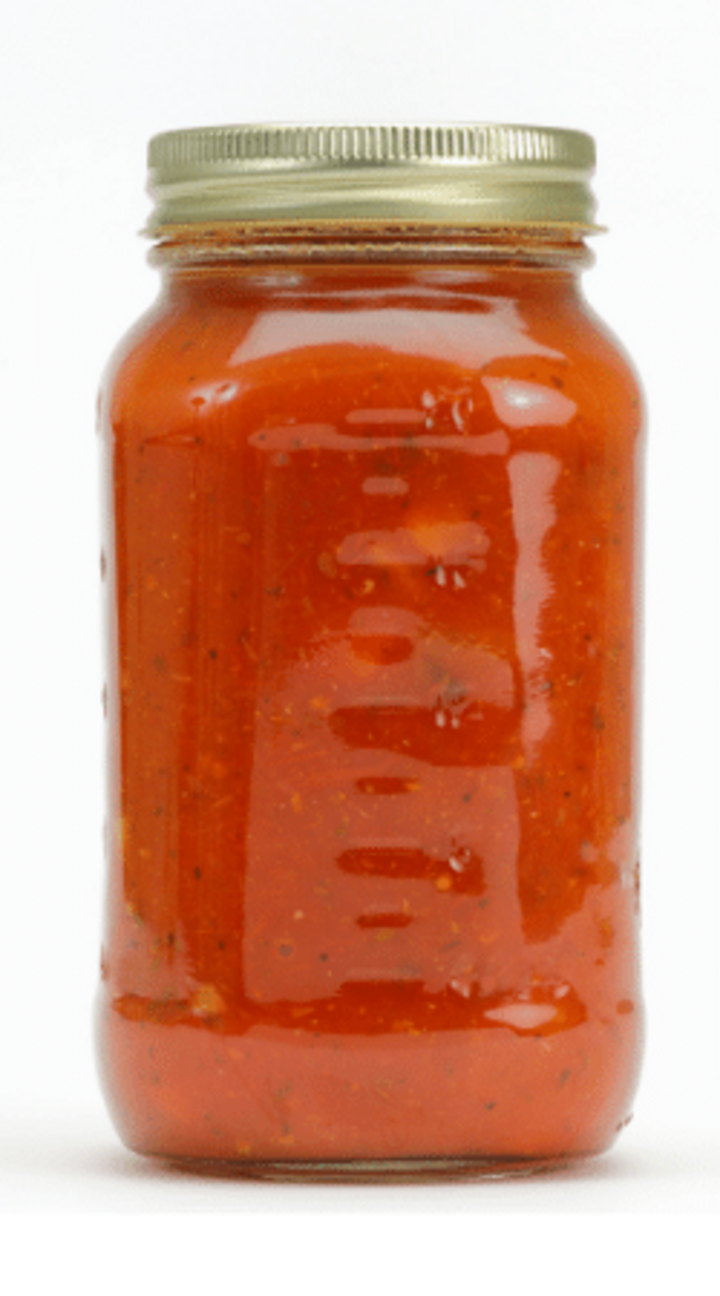
- 1 cup chopped onions
- 5 cloves garlic, minced
- 1 cup chopped celery or green peppers
- 1 pound fresh mushrooms, sliced (optional)
- 4 ½ teaspoons salt
- 2 tablespoons oregano
- 4 tablespoons minced parsley
- 2 teaspoons black pepper
- ¼ cup brown sugar
- ¼ cup vegetable oil
Yield: about 9 pints
CAUTION: Do not increase the proportion of onions, peppers, or mushrooms.
- Wash hands with soap and water. Make sure counters and equipment are clean. Wash tomatoes and dip them in boiling water for 30 to 60 seconds or until skins split. Dip in cold water and slip off skins. Remove cores and quarter tomatoes. Boil tomatoes 20 minutes, uncovered, in large saucepan. Put through food mill or sieve.
- Sauté onions, garlic, celery or peppers, and mushrooms (if desired) in vegetable oil until tender. Combine sautéed vegetables and tomatoes and add spices, salt, and sugar. Bring to a boil. Simmer, uncovered, until thick enough for serving. At this time, the initial volume will have been reduced by nearly one-half. Stir frequently to avoid burning.
- Fill sauce into prepared hot jars, leaving 1-inch headspace. Remove air bubbles and readjust headspace to 1-inch. Wipe rims of jars with a dampened clean paper towel. Adjust lids and bands. Process in a pressure canner according to Table 9.
Spaghetti Sauce with Meat
- 30 pounds tomatoes
- 2 ½ pounds ground beef or sausage
- 5 cloves garlic, minced
- 1 cup chopped onions
- 1 cup chopped celery or green peppers
- 1 pound fresh mushrooms, sliced (optional)
- 4 ½ teaspoons salt
- 2 tablespoons oregano
- 2 tablespoons minced parsley
- 2 teaspoons black pepper
- ¼ cup brown sugar
Yield: about 9 pints
CAUTION: Do not increase the proportion of onions, peppers, or mushrooms.
- Wash hands with soap and water. Make sure counters and equipment are clean.
- To prepare tomatoes, follow directions for Spaghetti Sauce without Meat. Sauté beef or sausage until brown. Add garlic, onion, celery or green pepper, and mushrooms, if desired. Cook until vegetables are tender. Combine with tomato pulp in large saucepan. Add spices, salt, and sugar. Bring to a boil. Simmer, uncovered, until thick enough for serving. At this time initial volume will have been reduced by nearly one-half. Stir frequently to avoid burning.
- Fill product into prepared hot jars, leaving 1-inch headspace. Remove air bubbles and readjust headspace to 1-inch. Wipe rims of jars with a dampened clean paper towel. Adjust lids and bands. Process in a pressure canner according to Table 9.
Return to top | Return to recipes
Mexican Tomato Sauce
2 ½ to 3 pounds chile peppers
3 cups chopped onions
1 tablespoon salt
18 pounds tomatoes
1 tablespoon oregano
½ cup vinegar
Yield: About 7 quarts
Caution: Wear plastic or rubber gloves and do not touch your face while handling or cutting hot peppers. If you do not wear gloves, wash hands thoroughly with soap and water before touching your face or eyes.
- Wash hands with soap and water. Wash and dry chiles. Slit each pepper on its side to allow steam to escape. Peel peppers by placing chiles in oven (400°F) or broiler for six to eight minutes until skins blister. Allow peppers to cool. Place in a pan and cover with a damp cloth. After several minutes, peel each pepper. Discard seeds and chop peppers.
- Wash tomatoes and dip in boiling water for 30 to 60 seconds or until skins split. Dip in cold water, slip off skins, and remove cores. Coarsely chop tomatoes and combine chopped peppers and remaining ingredients in large saucepan. Bring to a boil; cover and simmer 10 minutes. Fill jars; leave 1-inch headspace. Wipe rims of jars with a dampened clean paper towel. Adjust lids and bands. Process in a pressure canner according to Table 9.
Return to top | Return to recipes
Table 8: Processing Times for Tomatoes and Tomato Products in Boiling-water Canner or Steam Canner*
*A steam canner can only be use for processing times of 45 minutes or less.
| Tomato Product | Style of Pack | Jar Size | 0-1,000 ft | 1,001-3,000 ft | 3,001-6,000 ft | Above 6,000 ft |
|---|---|---|---|---|---|---|
| Tomato Juice | Hot | Pints Quarts | 35 min 40 min | 40 min 45 min | 45 min 50 min* | 50 min* 55 min* |
| Tomato and Vegetable Juice Blend | Hot | Pints Quarts | 35 min 40 min | 40 min 45 min | 45 min 50 min* | 50 min* 55 min* |
| Crushed Tomatoes (with no added liquid) | Hot | Pints Quarts | 35 min 45 min | 40 min 45 min | 45 min 55 min* | 55 min* 60 min* |
| Tomato Sauce | Hot | Pints Quarts | 35 min 40 min | 40 min 45 min | 45 min 50 min* | 50 min* 55 min* |
| Tomatoes, Whole or Halved (packed in water) | Hot or Raw | Pints Quarts | 40 min 45 min | 45 min 50 min* | 50 min* 55 min* | 55 min* 60 min* |
| Tomatoes, Whole or Halved (packed in tomato juice) | Hot or Raw | Pints or Quarts | 85 min* | 90 min* | 95 min* | 100 min* |
| Tomatoes Whole or Halved (packed raw without added liquid) | Raw | Pints or Quarts | 85 min* | 90min* | 95 min* | 100 min* |
*A steam canner can only be use for processing times of 45 minutes or less.
Return to top | Return to recipes
Table 9: Process Times for Tomatoes and Tomato Products in a Pressure Canner
| Dial-Gauge Canner Pressure (PSI) at Altitudes of: | Weighted-Gauge Canner Pressure (PSI) at Altitudes of: | |||||||
|---|---|---|---|---|---|---|---|---|
| Tomato Product | Style of Pack | Jar Size | Process Time | 0-2,000 ft | 2,000-4,000 ft | 4,000-6,000 ft | 0-1,000 ft | Above 1,000 ft |
| Tomato Juice | Hot | Pints or Quarts | 20 min 15 min | 6 lb 11 lb | 7 lb 12 lb | 8 lb 13 lb | 5 lb 10 lb | 10 lb 15 lb |
| Tomato and Vegetable Juice Blend | Hot | Pints or Quarts | 20 min 15 min | 6 lb 11 lb | 7 lb 12 lb | 8 lb 13 lb | 5 lb 10 lb | 10 lb 15 lb |
| Tomatoes, Crushed (no added liquid) | Hot | Pints or Quarts | 20 min 15 min | 6 lb 11 lb | 7 lb 12 lb | 8 lb 13 lb | 5 lb 10 lb | 10 lb 15 lb |
| Tomato Sauce | Hot | Pints or Quarts | 20 min 15 min | 6 lb 11 lb | 7 lb 12 lb | 8 lb 13 lb | 5 lb 10 lb | 10 lb 15 lb |
| Tomatoes, Whole or Halved (packed in water) | Hot or Raw | Pints or Quarts | 15 min 10 min | 6 lb 11 lb | 7 lb 12 lb | 8 lb 13 lb | 5 lb 10 lb | 10 lb 15 lb |
| Tomatoes, Whole or Halved (packed in tomato juice) | Hot or Raw | Pints or Quarts | 40 min 25 min | 6 lb 11 lb | 7 lb 12 lb | 8 lb 13 lb | 5 lb 10 lb | 10 lb 15 lb |
| Tomatoes, Whole or Halved (packed raw without added liquid) | Raw | Pints or Quarts | 40 min 25 min | 6 lb 11 lb | 7 lb 12 lb | 8 lb 13 lb | 5 lb 10 lb | 10 lb 15 lb |
| Spaghetti Sauce without Meat | Hot | Pints Quarts | 25 min 40 min | 11 lb 11 lb | 12 lb 12 lb | 13 lb 13 lb | 10 lb 10 lb | 15 lb 15 lb |
| Spaghetti Sauce with Meat | Hot | Pints Quarts | 60 min 70 min | 11 lb 11 lb | 12 lb 12 lb | 13 lb 13 lb | 10 lb 10 lb | 15 lb 15 lb |
| Mexican Tomato Sauce | Hot | Pints Quarts | 20 min 25 min | 11 lb 11 lb | 12 lb 12 lb | 13 lb 13 lb | 10 lb 10 lb | 15 lb 15 lb |
Additional Information on Tomatoes:
Publication originally written by Julie Albrecht. Updated and reviewed by Brenda Aufdenkamp and Cindy Brison in 2020.
Sources:
Canning Tomato Products - Safety Guidelines, University of Minnesota Extension
The Case for Bottled Lemon Juice in Canning, Iowa State University Extension and Outreach
USDA Complete Guide to Home Canning. Agriculture Information Bulletin 539, 2015, 009.
Ball Newell Brands, Ball Blue Book Guide to Preserving, 2020
This article has been peer-reviewed. It was updated in 2024.
Tags:
